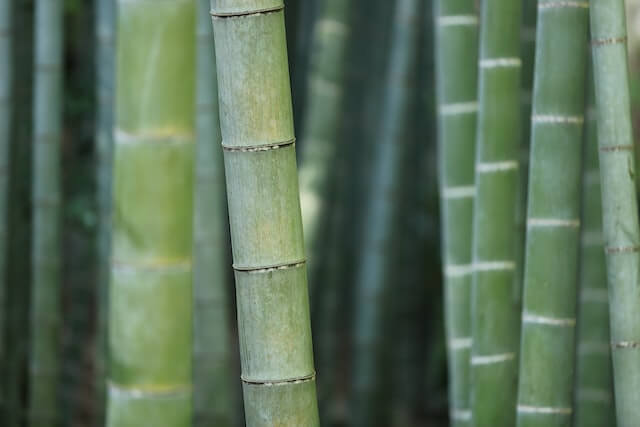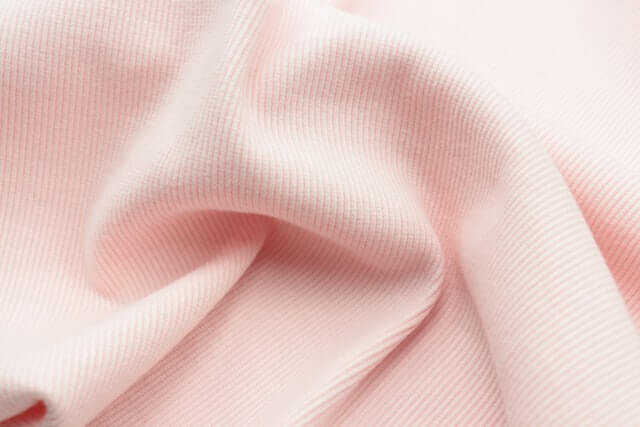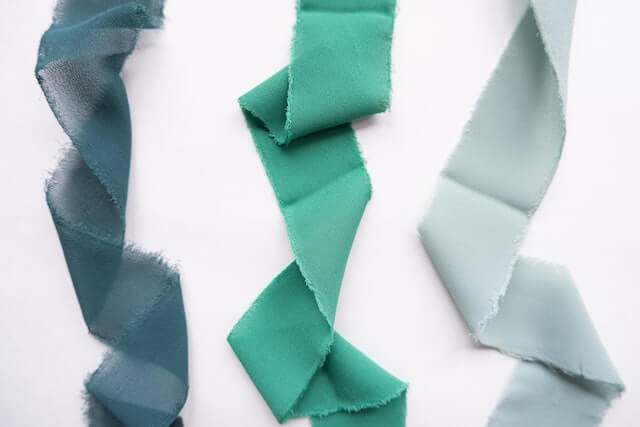Sourcing or developing products like lingerie with such wide varieties can be tough, especially if we consider all the different types of lingerie fabrics available today.
To make things even more confusing, you might encounter different material descriptions and must learn to differentiate between fibers and fabrics.
Fibers are what fabrics are made of, whether natural or man-made. They’re practically the building blocks of fabrics. To get a solid piece of fabric, people either knit or weave different fibers together.
Here, we’ll see the most common types of fibers and fabrics used for lingerie, and help you choose the best lingerie material.
So, let’s dive right in!
Types of Fibers
When we talk about fibers, we can distinguish between all-natural fibers derived from animal or plant sources, such as hemp, cotton, bamboo, or wool, versus man-made fibers like nylon or spandex.
Having said that, here are the most common types of fibers used to produce lingerie fabrics:
Silk

Silk, a natural fiber derived from the cocoons of silkworms, has been a popular choice for lingerie fabrics for centuries. Its shimmering appearance, soft texture, and remarkable capacity for absorbing dyes make it ideal for creating exquisite lingerie pieces.
In addition, silk is hypoallergenic and has excellent moisture-wicking properties, making it ideal for intimate apparel.
Pros
- Luxurious and elegant look and feel
- Soft and comfortable to wear
- A strong and durable fiber
- Hypoallergenic and gentle on the skin
- Moisture-wicking properties, breathable, and temperature regulating
- Outstanding dye absorption resulting in vibrant colors
Cons
- More expensive than other fabrics
- Needs special care, such as hand-washing or dry-cleaning
- Prone to wrinkling and creasing
- Easily damaged by perspiration, chemicals, or sunlight
- Limited stretch and elasticity
- No structure or support
Cotton

Cotton is a natural fiber used in textiles for thousands of years. Due to its softness, strength, and high absorbency, it’s still a popular choice for lingerie fabrics today.
The most significant benefit of using cotton in lingerie is its ability to breathe and wick moisture away from the skin.
Pros
- Soft, breathable, and comfortable for everyday wear
- Strong and durable
- High absorbency and moisture-wicking properties
- Can be printed with a variety of patterns and designs
- Affordable compared to other fabrics like silk
Cons
- Not as high-end or luxurious as silk
- Not much support or structure
- Can shrink or lose shape
Spandex (Lycra)

Spandex, also known by the brand name Lycra, is a highly stretchable and resilient fiber widely used in lingerie. It’s often blended with other fibers to provide additional flexibility and support and mold perfectly to a person’s body shape.
Due to these properties, spandex is commonly used in lingerie that requires compression and support, such as shapewear and sports bras.
Pros
- High stretch and recovery properties for a perfect fit
- Excellent compression and support
- Breathable and moisture-wicking properties
- Suitable for both knit and woven fabrics
- Ideal for activewear and shapewear
Cons
- Could be more expensive than other fibers
- Might lose elasticity over time
- Prone to pilling and snagging
Linen

Linen is a versatile and durable fiber that’s been used for ages in various garments, including lingerie. It’s made from the fibers of the flax plant and is known for its natural, earthy look and feel.
Although linen isn’t the most popular choice for lingerie today, its breathable properties make it ideal as loungewear for warm weather and humid climates.
Pros
- Breathable and moisture-wicking
- Anti-bacterial and hypoallergenic
- Durable and long-lasting
- A natural, sustainable, and eco-friendly fiber
Cons
- Prone to wrinkles
- May shrink or stretch with washing
- Rough to the touch
- Limited colors and prints
- Not suitable for compression, shaping, or support
Bamboo

Bamboo fiber is a sustainable option for lingerie fabrics. It’s made from the pulp of bamboo grass and is known for its soft and breathable properties.
Although bamboo is known as a sustainable source, the production of bamboo fabric can involve the use of chemicals, so not all bamboo fabrics are environmentally friendly.
Pros
- Natural, soft, and breathable
- Moisture-wicking and hypoallergenic
- Available in different weights and textures
Cons
- Not all bamboo fabrics are environmentally friendly
- Not a lot of colors and prints are available
- Lack of support and compression properties
Nylon

Although it might not be the best-looking out there, nylon is an extremely strong, elastic fiber that has been popular in women’s lingerie for decades. It’s easy to care for and wash and lasts a long time.
Having said that, nylon is not a breathable fabric and can trap moisture against the skin.
Pros
- Cheaper than other fabrics
- A strong and durable fiber
- Easy to care for and maintain
Cons
- Can look cheap
- Not breathable and traps moisture
- Not suitable for hot or humid weather
Rayon

Next, we have rayon – a semi-synthetic cellulose fiber that was originally produced as a silk replacement. Some different types of rayon fabrics you might have heard of are lyocell (Tencel), modal, and viscose.
Pros
- A versatile look
- An excellent fiber for summer lingerie
- Highly absorbent
Cons
- Not too suitable for winter and cold weather
- Lack of support, shape, and compression
Merino Wool

Merino wool is a high-quality natural fiber prized for its softness, durability, and breathability. It’s a popular choice for activewear and outdoor apparel due to its excellent moisture-wicking properties and ability to regulate body temperature.
Pros
- Soft, comfortable, and breathable
- Warm and temperature-regulating
- Odor-resistant
- Suitable for activewear
Cons
- Expensive
- Requires special care
- May not be suitable for sensitive skin
- Could cause allergic reactions or itchiness
Hemp

Hemp is a highly durable material, making it a great choice for lingerie that’s meant to last. It’s naturally breathable and moisture-wicking, helping to regulate body temperature and prevent odor buildup.
Pros
- Durable and breathable
- Hypoallergenic
- Sustainable and biodegradable
Cons
- Limited availability and variety
- Might require special care
- Wrinkles easily
Knit Lingerie Fabrics
Now that we’ve seen the different types of fibers used in the production of fabrics, it’s time to go over the most popular fabrics.
We can divide lingerie fabrics into two categories: knit fabrics and woven fabrics. Let’s look at knit lingerie fabrics first.
Nylon Tricot

Nylon tricot is a lightweight and durable fabric with a zigzag structure when looked up close. It has a smooth and shiny texture that feels soft against the skin, making it a popular choice as both an outer fabric and a lining.
Pros
- Soft, smooth, and lightweight
- Durable and long-lasting
- Stretchy and form-fitting
- Low maintenance
Cons
- Not as breathable as other fabrics
- Prone to pilling
- Not as luxurious or glamorous
Stretch Lace

Stretch lace is a delicate and intricate fabric often used for the decorative elements of lingerie. It’s lightweight and stretchy, providing a comfortable and snug fit.
As such, stretch lace is often used for bralettes, panties, and other lingerie items that require a feminine touch with added elasticity.
Pros
- Feminine and delicate
- Elastic, stretchy, and form-fitting
- Breathable and moisture-wicking
- More affordable compared to other lace types
Cons
- Delicate and prone to snagging or tearing
- Less eco-friendly (made from synthetic materials)
Stretch Velvet

Considered one of the most luxurious and fancy lingerie fabrics, stretch velvet features a plush texture and a rich appearance.
The sleek and elegant look combined with the comfort that comes with the slight stretch makes this velvet a really popular choice.
Pros
- Elastic and stretchy
- Luxurious and high-end feel and look
Cons
- Heavyweight
- Prone to wrinkles
Single Jersey

The single jersey can be made of different fibers, such as rayon, bamboo, cotton, polyester, etc. Jersey materials stretch, drape, and fall very well, making them suitable for everything from babydolls to nightgowns.
Pros
- Drapes well
- Lightweight and comfortable
Cons
- Can lose shape over time with regular wearing and washing
Light Double Knits

Thicker and sturdier than single-knit fabrics, lightweight double knits like cotton interlock can be a great alternative providing more support and stability when needed. Bras and shapewear are just some examples of lingerie that can be produced with this double-knit construction fabric.
Pros
- Versatile
- Durable
- Extra support and shape
Cons
- Can be too thick and heavy for some types of lingerie
Simplex

Simplex is a smooth and silky fabric often used for the cups of bras and other lingerie items that require a supportive and structured fit. It has a firm texture that provides excellent support and shape, making it a popular choice for underwire bras.
Pros
- Ideal for supporting and shaping lingerie
- Great for underwire bras
Cons
- Not suitable for all lingerie
- Can be too heavy and sturdy
Mesh

Next, we have mesh – a breathable and lightweight fabric used in lingerie for its sheer and transparent qualities. You can usually use mesh for the decorative elements of lingerie, such as straps, panels, or trims.
Pros
- Adds sheer and transparency to elements
- Breathable and lightweight
Cons
- Prone to tearing
- Lacks strength
- Lacks coverage
Power Net

Power net is a strong and durable fabric commonly used in shapewear and other body-hugging lingerie garments. Its tight-knit construction provides excellent support and shaping, making it ideal for contouring the body.
Pros
- Strong and durable
- Excellent support and shaping
- Great for activewear and shapewear
Cons
- Thick and uncomfortable for prolonged wear
Microfiber

This is a soft and lightweight fabric commonly used in lingerie for its breathable and moisture-wicking properties. It provides a comfortable and seamless fit, making it a popular choice for panties, bras, and other undergarments requiring smooth fabric.
Pros
- Soft and lightweight
- Breathable and moisture-wicking
Cons
- Loses its shape in time
Woven Lingerie Fabrics
Now, let’s look at some of the most popular woven lingerie fabrics you could use:
Lace

Lace is a delicate fabric used in lingerie to add a touch of elegance and sensuality. It’s characterized by its intricate patterns created by weaving or embroidering threads in a variety of ways.
Lace can be made from different materials, including cotton, silk, and synthetic fibers.
Pros
- A feminine and delicate fabric
- Can be made from different fibers
- Is versatile and can be used for different lingerie garments
Cons
- Can feel uncomfortable, scratchy, or itchy against the skin
- Lacks strength and can tear or break easily
- Difficult to clean and maintain
Satin

Satin is a luxurious silk-like fabric often used in lingerie to create a soft and smooth texture. It’s made from a range of fabrics, including silk, polyester, and nylon, and is characterized by its lustrous finish and glossy appearance.
Pros
- A smooth, luxurious, and silky appearance
- Cheaper than silk
- Falls and drapes well
- Very durable
Cons
- Shows sweat stains easily
- Requires special care
- Might feel slippery and sticky
Organza

Organza is a sheer and lightweight fabric commonly used in lingerie to create a delicate and airy feel. It’s made from a blend of silk and synthetic fibers and is characterized by its crisp texture and translucent appearance.
Pros
- Lightweight and sheer
- Adds texture and volume, and is great for layering
Cons
- Stiff and scratchy
- Wrinkles easily
- Requires special care
Chiffon

The next fabric we’re going to see is chiffon, which can be made from a range of materials such as silk, polyester, and nylon, and it has a sheer texture and airy drape. Chiffon lingerie can be found in various styles, including babydolls, chemises, and robes.
Pros
- Sheer and lightweight
- Great draping, flow, and movement
- Adds volume to lingerie
Cons
- Fragile and prone to tears
- Doesn’t provide enough coverage
Georgette

Georgette is similar to chiffon, with a flowing texture, sheer appearance, and slightly crinkled fabric. Like chiffon, georgette is also used for chemises, camisoles, and robes.
Pros
- Lightweight and sheer
- Adds texture to lingerie and drapes well
Cons
- Prone to tears
- Not enough coverage
Charmeuse

This smooth and silky fabric is often used in lingerie to create a luxurious and sensual feel. It’s one of the most high-end materials you can get, as the material has such a high shine it looks almost liquid.
Pros
- Smooth, silky, and durable
- Drapes well and falls beautifully
Cons
- May show stains easily
- Might require special care and maintenance
China Silk

Otherwise known as lining fabric or habotai, china silk is an inexpensive choice of lingerie material. It’s very thin and soft, which is why it’s usually used as a lining fabric for lingerie.
Pros
- Breathable, light, and soft
- Very thin and suitable for layering
Cons
- Best for lining material
- Not too suitable as an outer fabric
FAQs about Lingerie Fabrics
As always, let’s go through all the most commonly asked questions on the subject of lingerie fabrics and materials.
What to Consider When Choosing Lingerie Fabrics?
Here are some important considerations when choosing the right lingerie fabric for your product:
- Type of lingerie: this will give you the purpose of the fabric (supportive, stretchy, silky and flowing, etc.);
- Price range: are you going for fancy high-end fabrics or cheaper alternatives;
- Fabric stretch: how elastic do you need your fabric to be (percentage of stretch)
- Fabric weight: thickness, bulk, and weight of the fabric play a huge part in the design of lingerie;
- Look and feel: are you going for a high-end luxurious feel or a comfortable, everyday look;
- MOQ: the minimum quantity you’re prepared to buy and sell;
- Product development: are you looking for suppliers offering OEM, ODM, private labeling, or product development from scratch;
- Supplier availability: can you find suppliers and backup suppliers for the type of lingerie fabrics needed;
Which Lingerie Material Is Most Suitable for Bras?
Some of the most suitable materials for bras are cotton, microfiber, spandex, and elastin. Some special-occasion bras might also use elements made from satin, silk, mesh, or lace. Ultimately, it all depends on the type of bras you need.
Which Lingerie Material Is Most Suitable for Underwear?
Some great lingerie fabrics for underwear are cotton, modal (a type of rayon), microfiber, or lace. These fabrics are often blended with fibers of elastin or spandex to provide additional elasticity.
Should I Choose a Fancy Lingerie Fabric or a Cheap One?
As a seller, fancy lingerie is more of a mid- or even high-end product and, as such, it can give you better profit margins and the possibility to develop a long-lasting brand.
However, it all depends on your target group and audience. In some instances, selling lower-ticket products like cheaper lingerie might help you make more sales quicker.
Where to Find Lingerie Fabrics for Sale?
Here are some great lingerie fabric sources:
- B2B marketplaces like Alibaba;
- Google to search for lingerie wholesale suppliers;
- Online supplier directories;
- Visit trade shows in China;
- Work with a local sourcing agent in China;
Summary
Choosing the right lingerie fabrics, especially if you’re planning to develop a brand-new lingerie product, can make or break your business. Lingerie fabrics are the difference between a cheap-looking set of lingerie and high-end lingerie, so hopefully, we’ve helped you choose wisely.
If you need help sourcing different lingerie fabrics, get in touch and ask for a free quote – zero upfront costs, zero obligations.

